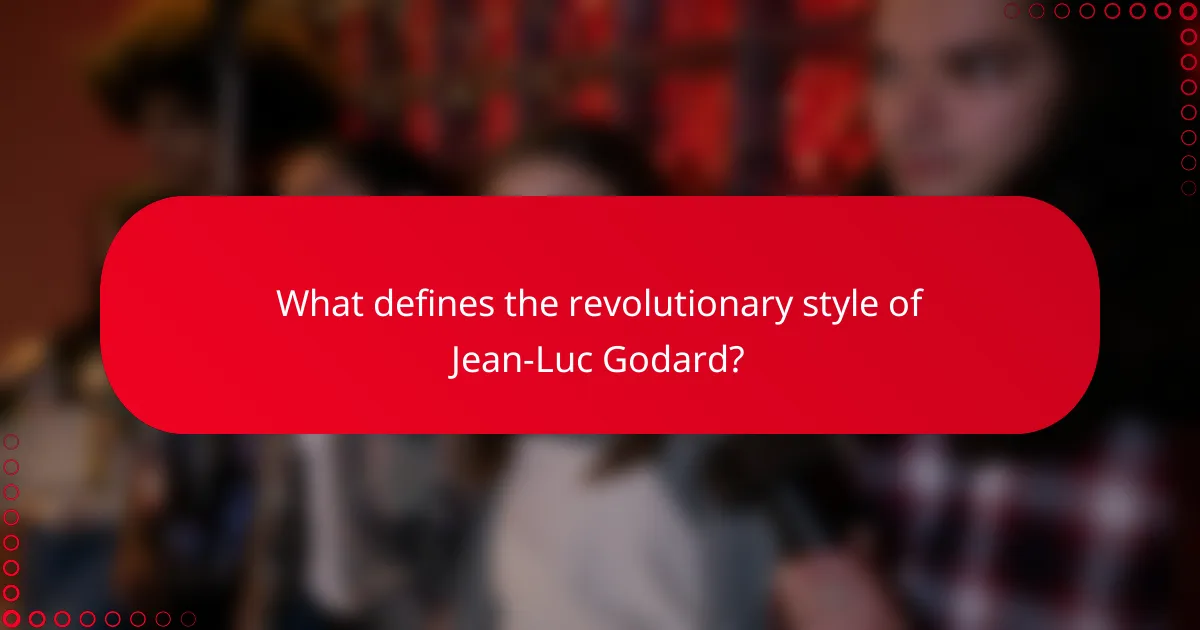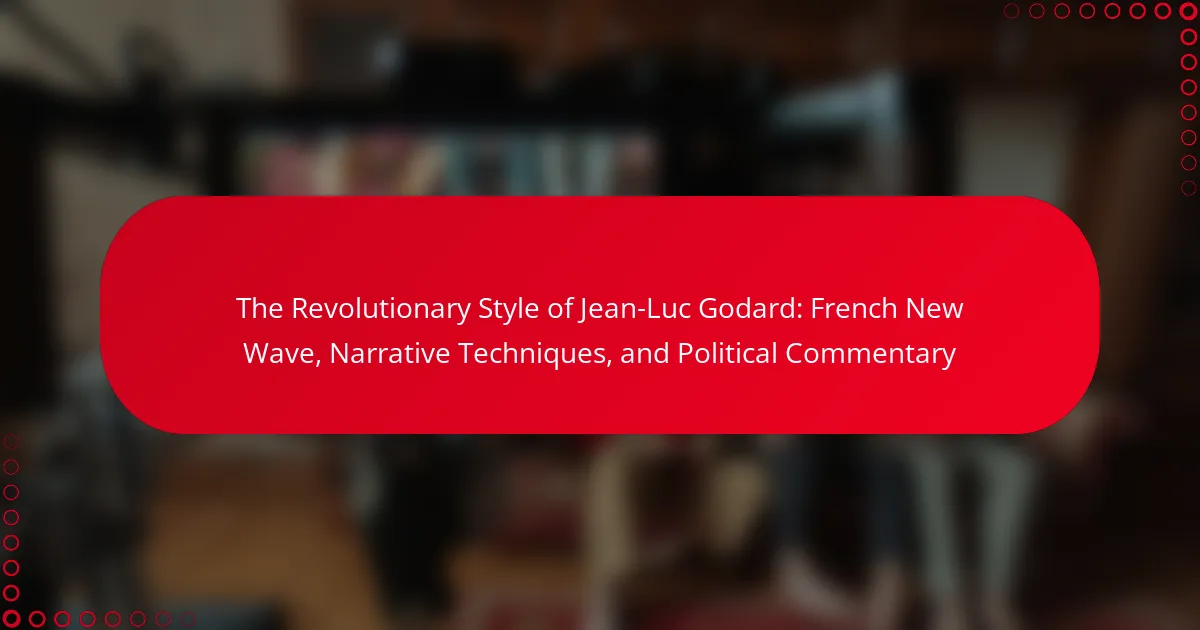Jean-Luc Godard is a pivotal figure in cinema, known for his revolutionary style that combines innovative narrative techniques with political commentary. His use of jump cuts and non-linear storytelling challenges traditional filmmaking norms, encouraging critical engagement from viewers. Godard’s films often reflect the social upheaval of the 1960s through direct political messages, while his incorporation of intertextuality and experimentation with sound and visual aesthetics deepen the emotional resonance of his work. This article explores Godard’s influence on modern cinema and his role in shaping the French New Wave movement.

What defines the revolutionary style of Jean-Luc Godard?
Jean-Luc Godard’s revolutionary style is defined by his innovative narrative techniques and political commentary. He broke traditional storytelling norms by employing jump cuts, which created a disjointed yet engaging viewing experience. Godard often used non-linear narratives, challenging viewers to think critically about the plot. His films frequently incorporated direct political messages, reflecting the social upheaval of the 1960s. Godard’s use of intertextuality, referencing other films and art forms, added depth to his work. He also experimented with sound and visual aesthetics, enhancing the emotional impact of his stories. This unique approach influenced countless filmmakers and reshaped modern cinema. Godard’s pioneering work remains a cornerstone of the French New Wave movement.
How did Godard influence the French New Wave movement?
Jean-Luc Godard significantly influenced the French New Wave movement through his innovative narrative techniques and stylistic choices. He challenged traditional storytelling by employing jump cuts and breaking the fourth wall. Godard’s films often featured fragmented narratives that reflected contemporary social issues. His work emphasized realism and spontaneity, diverging from polished cinematic conventions. He also incorporated political commentary, making films that questioned authority and societal norms. Godard’s influence is evident in the works of other New Wave directors who adopted his experimental approach. His film “Breathless” is a prime example of this influence, showcasing a new style that reshaped cinematic language. Godard’s contributions helped define the French New Wave as a revolutionary movement in cinema.
What are the key characteristics of the French New Wave?
The key characteristics of the French New Wave include innovative storytelling, unconventional editing, and a focus on realism. Filmmakers often employed jump cuts and non-linear narratives. They also favored location shooting over studio sets. The movement emphasized personal expression and artistic freedom. Directors like Jean-Luc Godard challenged traditional cinematic conventions. Themes often explored existentialism and social issues. The use of handheld cameras created a sense of immediacy. This movement emerged in the late 1950s and influenced global cinema significantly.
Which films exemplify Godard’s contributions to this movement?
Breathless, Vivre Sa Vie, and Alphaville exemplify Jean-Luc Godard’s contributions to the French New Wave movement. Breathless, released in 1960, introduced innovative editing techniques and jump cuts. Vivre Sa Vie, from 1962, focused on existential themes and character-driven narratives. Alphaville, released in 1965, combined science fiction with political commentary. Each film showcases Godard’s unique narrative style and bold visual aesthetics. These works significantly influenced modern cinema and challenged traditional filmmaking conventions.
What narrative techniques are prominent in Godard’s films?
Jean-Luc Godard’s films prominently feature techniques such as non-linear storytelling, jump cuts, and self-reflexivity. Non-linear storytelling disrupts traditional narrative flow, often presenting events out of chronological order. This technique engages viewers by challenging their expectations. Jump cuts break the continuity of time and space, creating a sense of disorientation. Godard uses this to emphasize the artificiality of film. Self-reflexivity involves acknowledging the film as a constructed medium. This technique prompts audiences to reflect on the nature of cinema itself. Godard’s films often include direct address to the camera, further breaking the fourth wall. These narrative techniques contribute to a unique cinematic experience that defines his revolutionary style.
How does Godard utilize non-linear storytelling?
Godard utilizes non-linear storytelling by disrupting traditional narrative structures. He often employs flashbacks and fragmented sequences. This technique creates a disjointed viewing experience. It challenges the audience’s perception of time and causality. For instance, in “Breathless,” scenes are presented out of chronological order. This method enhances emotional impact and thematic depth. Godard’s approach reflects the chaotic nature of modern life. His non-linear style is a hallmark of the French New Wave movement.
What role do jump cuts play in his narrative style?
Jump cuts are a significant element in Jean-Luc Godard’s narrative style. They create a sense of disorientation and fragmentation. This technique breaks the continuity of time and space in storytelling. Jump cuts challenge traditional cinematic conventions. They force viewers to engage actively with the narrative. Godard often uses jump cuts to emphasize character emotions or thematic shifts. This approach enhances the film’s political commentary by disrupting narrative flow. It reflects the chaotic nature of modern life. Godard’s innovative use of jump cuts has influenced countless filmmakers.
How does Godard incorporate political commentary in his work?
Godard incorporates political commentary in his work through innovative narrative techniques and visual style. He often blends fiction with documentary elements to challenge traditional storytelling. His films address contemporary social issues, including war, capitalism, and consumerism. For instance, “La Chinoise” critiques Marxist ideology and the youth’s political engagement in the 1960s. Godard’s use of jump cuts and fragmented narratives emphasizes the chaos of political discourse. He also employs intertextual references to engage viewers with historical and political contexts. The film “Weekend” critiques bourgeois society and consumer culture, showcasing his disdain for materialism. Overall, Godard’s approach invites reflection on the political landscape of his time.
What themes of social critique are prevalent in his films?
Jean-Luc Godard’s films often critique consumerism, capitalism, and societal norms. His work challenges traditional narrative structures and promotes political awareness. Godard’s films reflect a disillusionment with modern life. He addresses issues like alienation and the impact of media on perception. His use of jump cuts and unconventional storytelling emphasizes fragmentation in society. Godard’s characters frequently grapple with existential dilemmas. He also critiques the film industry itself, highlighting its commercialism. These themes resonate with the socio-political climate of the 1960s and beyond.
How does Godard’s political perspective shape his storytelling?
Godard’s political perspective profoundly influences his storytelling. His films often reflect a critique of capitalist society and consumerism. He employs unconventional narrative techniques to challenge traditional storytelling. For example, Godard frequently breaks the fourth wall, engaging viewers in political discourse. His use of jump cuts disrupts narrative continuity, mirroring societal fragmentation. Additionally, he integrates historical context into his plots, emphasizing political themes. Films like “La Chinoise” explicitly address revolutionary ideas and activism. Godard’s approach encourages audiences to question authority and societal norms. This political lens shapes not only the content but also the form of his cinema.
What are the lasting impacts of Godard’s style on cinema?
Godard’s style has profoundly influenced cinema through innovative narrative techniques and visual aesthetics. His use of jump cuts challenged traditional editing norms. This technique emphasizes the disjointedness of modern life. Godard’s incorporation of political commentary reshaped the role of cinema as a medium for social critique. His films often blur the line between fiction and reality, prompting audiences to question the nature of storytelling. The casual breaking of the fourth wall invites viewer engagement and self-reflection. His influence is evident in the works of contemporary filmmakers like Quentin Tarantino and Richard Linklater. They adopt similar narrative experimentation and self-referential techniques. Godard’s legacy continues to inspire filmmakers seeking to push the boundaries of conventional cinema.
How have contemporary filmmakers been influenced by Godard?
Contemporary filmmakers have been significantly influenced by Jean-Luc Godard’s innovative techniques. His use of jump cuts reshaped narrative pacing in cinema. This editing style allows for a more fragmented storytelling approach. Filmmakers like Quentin Tarantino and Richard Linklater incorporate similar techniques in their work. Godard’s focus on political commentary has also inspired filmmakers to weave social critique into their narratives. His blending of genres encourages contemporary directors to experiment with form and style. Additionally, Godard’s emphasis on self-reflexivity influences filmmakers to challenge audience expectations. This has led to a more diverse range of storytelling methods in modern cinema.
What elements of Godard’s style are still relevant today?
Godard’s style remains relevant today through his innovative narrative techniques and political commentary. His use of jump cuts challenges traditional storytelling and influences contemporary filmmakers. The incorporation of direct address to the audience creates a sense of engagement still seen in modern cinema. Godard’s blending of genres prompts filmmakers to experiment with form and content. Additionally, his focus on socio-political issues resonates with current global concerns. The self-reflexive nature of his films encourages critical viewing, a practice embraced by today’s audiences. Overall, these elements continue to shape filmmaking and narrative approaches in contemporary cinema.
How can one appreciate the complexity of Godard’s films?
One can appreciate the complexity of Godard’s films by analyzing their innovative narrative structures. Godard often employs non-linear storytelling, which challenges traditional cinematic conventions. His films frequently break the fourth wall, creating a dialogue between the film and the audience. This technique invites viewers to engage critically with the content. Additionally, Godard’s use of jump cuts disrupts the flow of time and space, enhancing the viewer’s experience. His incorporation of political themes reflects the socio-political context of the era, adding layers of meaning. The intertextuality present in his work references various art forms, enriching the narrative. Understanding these elements allows for a deeper appreciation of his artistic vision.
What should viewers look for when watching a Godard film?
Viewers should look for innovative narrative techniques in a Godard film. Godard often breaks traditional storytelling structures. He employs jump cuts, non-linear timelines, and fragmented narratives. These techniques challenge conventional viewing experiences. Additionally, viewers should note the political commentary present in his films. Godard often critiques society and culture through dialogue and imagery. The use of intertextuality is also significant. Godard references other films, art, and literature, enriching the viewing experience. Lastly, pay attention to the visual style. His films often feature bold colors and unconventional framing. These elements contribute to the overall impact of his work.
How can understanding the historical context enhance the viewing experience?
Understanding the historical context enhances the viewing experience by providing deeper insight into the film’s themes and techniques. Historical context reveals the socio-political climate during the film’s production. For example, Jean-Luc Godard’s works emerged during the 1960s, a period marked by political upheaval and cultural shifts. This background helps viewers appreciate the revolutionary narrative techniques he employed. Recognizing the influence of events like the May 1968 protests enriches the audience’s interpretation of his commentary. Additionally, understanding the evolution of French cinema during this time highlights Godard’s departure from traditional storytelling. This awareness allows viewers to grasp the significance of his stylistic choices, such as jump cuts and breaking the fourth wall. Overall, historical context transforms passive viewing into an active engagement with the film’s message.
The main entity of the article is Jean-Luc Godard, a pivotal figure in the French New Wave movement. The article examines Godard’s revolutionary cinematic style characterized by innovative narrative techniques, including non-linear storytelling and jump cuts, as well as his political commentary that reflects the social upheaval of the 1960s. It highlights key films such as “Breathless,” “Vivre Sa Vie,” and “Alphaville,” showcasing his influence on contemporary cinema. Additionally, the article discusses how Godard’s unique approach to storytelling and visual aesthetics has left a lasting impact on filmmakers and reshaped modern cinematic language.
